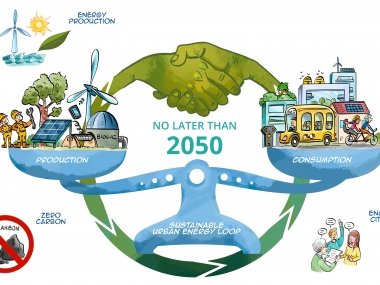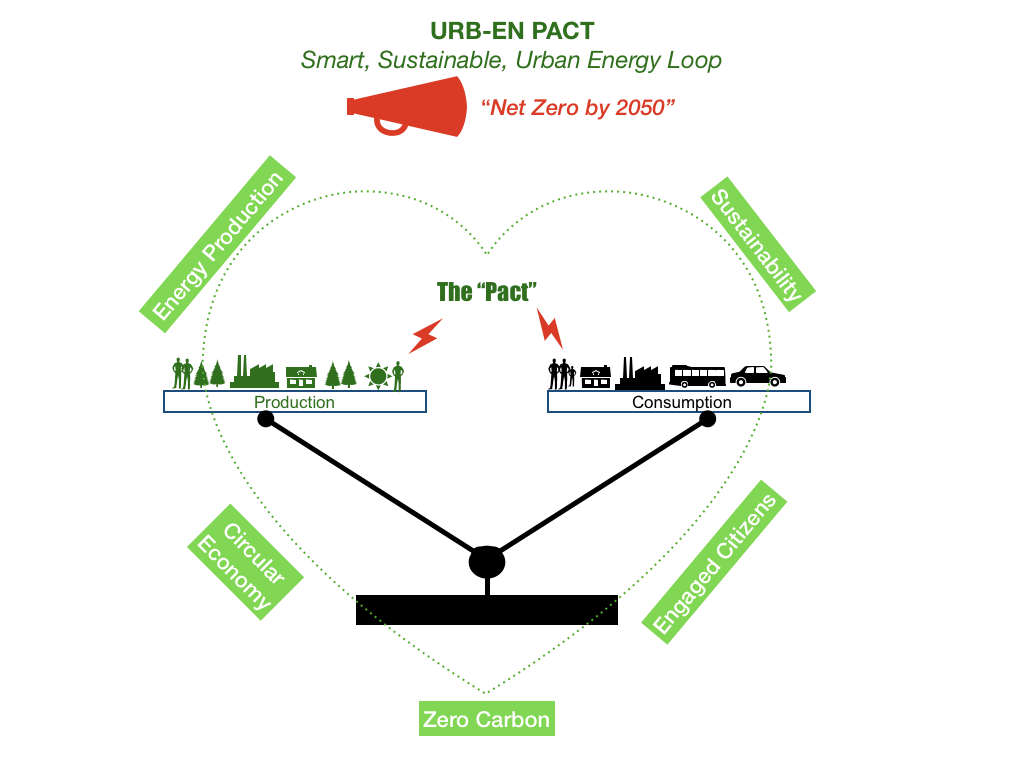Preparing Net Zero Energy for cities and regions
Edited on
08 September 2020The URB-EN PACT project will develop a method for city-regions to prepare Net Zero Energy action plans.

The Paris Agreement covers greenhouse-gas-emissions mitigation, adaptation, and finance. Its terms were finalised at the 2015 United Nations Climate Change Conference, COP 21, held in Paris, France. It was signed in 2016. The 196 participating countries agreed to a global pact, called the Paris Agreement or Paris Protocol, to reduce their carbon output "as soon as possible”. They also committed to do their best to keep global warming "to well below 2 degrees C” compared to pre-industrial levels. Countries also agreed to "pursue efforts to" limit the temperature increase to 1.5 °C where possible. The 1.5 °C goal will require zero emissions sometime between 2030 and 2050, and this is what is driving cities to take action now.
Cities and energy consumption
In 1900, just 13% of the global population lived in cities. By 2015, the figure was more than 50%. So it is not surprising that it is cities where most of the world’s population live. This explains why around 70% of total global energy-related carbon dioxide emissions comes from urban areas.
Some cities are already well advanced in their implementation of Net Zero Energy processes. For example, Copenhagen has a plan to become a Net Zero Energy city by 2025 . But Copenhagen has been at the forefront of sustainable urban policies for many decades. What about other cities - “typical cities” - whose experience of implementing environmental policies is less developed?
The URB-EN PACT Project
URB-EN PACT is a partnership project for “typical” European cities, not just those that are well advanced in achieving energy sustainability. The Project’s partners are diverse in terms of their geographic location, size, demographic profile, industry profile, and experience of implementing energy efficient measures. The nine partners represent seven European nations, each of which has distinctive energy policies and energy mix. This can be seen clearly from the following table that provides summary data for each partner.
The diversity of the partners is a key strength of the project. It ensures that the challenges faced by quite different city regions in reaching Net Zero status can be assessed. For example, at least one of the partners has a steel-making plant (carbon generator) within its boundary while another has a large urban forest (carbon sink). The profile of stakeholders who must be engaged in each of these cities will be very different. Having the opportunity to develop and test a process that is applicable to both of these cities will make the project output more robust.
Partner | Country (and approx location) | Population [‘000] | City-Region Type | National Energy mix |
Alto Minho [Region]
| Portugal (region North of Porto) | 231 | Urban, low density territory comprising several small cities | Thermal (65%), Wind (20%), Hydro (13%), Other (2%). |
Bialystok | Poland (North East) | 416 | Urban, medium density | Coal (79%), Gas (5.8%), Renewable (7.2%), Hydro (1%), Other (6.1%) |
Clermont-Auvergne Metropole [Lead Partner] | France (Central) | 288 | Urban, medium density | Nuclear (75%), Hydro (10%), Gas (7%),Wind (4%), Coal (3%), Solar (2%) |
Elefsina | Greece (West of Athens) | 31 | Urban, low density | Oil (49%), Coal (21%), Gas (19%), Biofuels & Waste (6%), Geothermal, Solar & Wind (5%) |
Galati | Romania (East) | 303 | Urban, medium density | Hydro (28%), Coal (27%), Oil & Gas (21%), Wind (14%), Nuclear (6%), Solar (3%) |
Metropole Rouen Normandie | France (North West) | 490 | Urban, medium density | Nuclear (75%), Hydro (10%), Gas (7%), Wind (4%), Coal (3%), Solar (2%) |
Palma di Montechiaro [Region] | Italy (Region South Sicily) | 22 | Urban, Low density | Gas (38%), Oil (38%), Renewables & Waste (13%), Coal (10%) [for Italy] |
Tampere | Finland (South West) | 237 | Urban, medium density | Nuclear (33%), CHP (heat 20%), Hydro (19%), CHP (Industry 15%), Condensing (12%) Wind (1%) |
Broad Stakeholder Engagement is essential
The scope or reach of the URB-EN PACT project is wide. The partners are focused on how energy is produced as well as consumed. They wish to stimulate a greater awareness of energy issues within their populations and to develop a culture of energy conservation amongst all consumer types (citizens and industry). Like COP21, URB-EN PACT recognises that it is essential for there to be a ‘pact’ between all of the cities’ stakeholders - focusing on one group or area will not lead to the required sustainable change.
URB-EN PACT’s goals include reducing demand for energy by both industry and citizens while also identifying how to replace fossil fuel generation with renewable sources. Each city’s energy mix will be unique to their needs and available resources. Already we have seen innovative solutions such as generating bio-gas from waste.
URB-EN PACT will also focus on activities that minimise our broader environmental impact. Thus, carbon reduction and circular economy principles will be included within its scope.

Although very early in the process, the kick-off meeting helped identify immediate areas of experience, which the partners could share. These included high efficiency street lighting, hydrogen for mobility, commercialising University research, community energy production, energy storage, citizen engagement and district heating enhancements. After just two City Visits, we have a range of suggestions for Small Scale Actions.
Active Engagement of Civic Leaders
The project recognises the central role that strong civic leadership plays in driving change. We are looking at how the partners’ Mayors can be engaged individually and collectively in an innovative way. URB-EN PACT is shaping up to be a very interesting project!
Submitted by Donal O'Herlihy on
